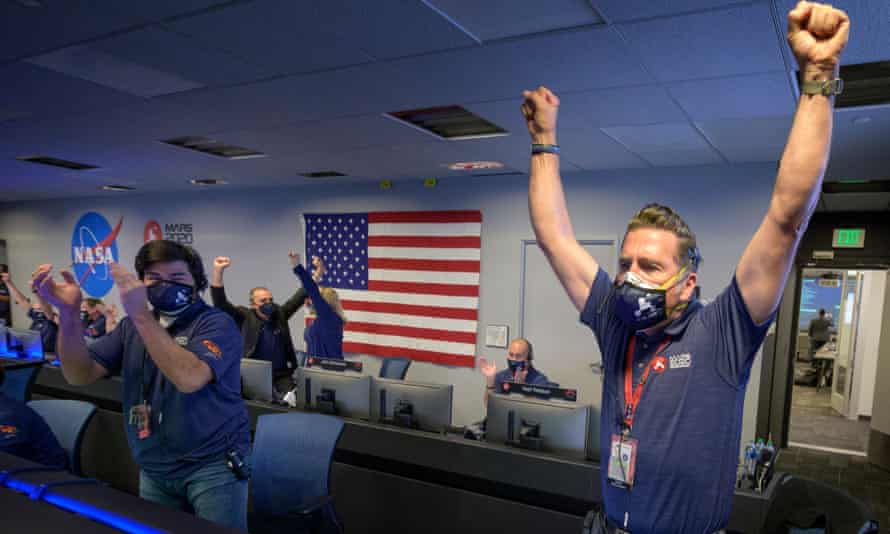Radio signals confirmed that the six-wheeled rover had survived its perilous descent and arrived within its target zone
Mission managers at Nasa’s jet propulsion laboratory near Los Angeles burst into applause and cheers as radio signals confirmed that the six-wheeled rover had survived its perilous descent and arrived within its target zone inside Jezero crater, site of a long-vanished Martian lake bed.
The robotic vehicle sailed through space for nearly seven months, covering 293m miles (472m km) before piercing the Martian atmosphere at 12,000mph (19,000km/h) to begin its approach to touchdown on the planet’s surface.
The spacecraft’s self-guided descent and landing during a complex series of maneuvers that Nasadubbed “the seven minutes of terror” stands as the most elaborate and challenging feat in the annals of robotic spaceflight.
“Touchdown confirmed! Perseverance safely on the surface of Mars, ready to begin seeking signs of past life,” flight controller Swati Mohan announced at mission control to back-slapping, fist-bumping colleagues wearing masks against the coronavirus.
A second round of cheers and applause erupted in the control room as the images of the surface arrived minutes after touchdown. Partially obscured by a dust cover, the first picture was a view from one of the Perseverance’s hazard cameras. It showed the flat, rocky surface of the Jezero crater.
A second image taken by a camera on board the spacecraft showed a view from behind the rover of the Jezero crater. The rover appeared to have touched down about 32 metres (35 yards) from the nearest rocks.

“It really is the beginning of a new era,” Nasa’s associate administrator for science, Thomas Zurbuchen, said earlier in the day during Nasa’s webcast of the event.
Perseverance approached Mars at around 12,400 miles per hour, although when it hit the top of the atmosphere, a heatshield slowed it down to about a tenth of this speed. Then a supersonic parachute popped out of the rover to reduce its speed to a few hundred miles per hour.
At that point, descending under the parachute, Perseverance was still travelling far too fast to land safely. So it cut itself loose from the parachute and used rocket thrusters to slow down further. The thrusters allowed it to hover roughly 20 metres above the surface, before the rover was lowered by cables to the surface using a rocket platform called a sky crane.
At post-landing briefing, Nasa’s acting chief, Steve Jurczyk, called it an “amazing accomplishment,” adding, “I cannot tell you how overcome with emotion I was”.
The descent and landing systems had “performed flawlessly”, said Matt Wallace, the deputy project manager for the rover, adding: “The good news is the spacecraft, I think, is in great shape,” said Matt Wallace, the mission’s deputy project manager.
The landing represented the riskiest part of two-year, $2.7bn endeavor whose primary aim is to search for possible fossilized signs of microbes that may have flourished on Mars about 3bn years ago, when the fourth planet from the sun was warmer, wetter and potentially hospitable to life.

Scientists hope to find biosignatures embedded in samples of ancient sediments that Perseverance is designed to extract from Martian rock for future analysis back on Earth – the first such specimens ever collected by humankind from another planet.
Two subsequent Mars missions are planned to retrieve the samples and return them to Nasa in the next decade.
President Joe Biden tweeted congratulations over the landing, saying: “Today proved once again that with the power of science and American ingenuity, nothing is beyond the realm of possibility.”
Perseverance is carrying a clutch of instruments designed to analyse rocks for biosignatures – chemical hallmarks of life – and will also store other samples from the planet’s surface. Future missions fuelled by Europe and the US will retrieve these samples and return them to Earth.
The emergence of life on Earth is an extraordinary event that is not fully understood, and ancient Mars had a much more benign climate than it has now, with many of the same raw materials that were available on Earth, said Colin Wilson, a physicist at Oxford University.
“Of all the steps needed to develop life, how many occurred on Mars? This [mission] tells us not only about whether we’re alone in the solar system but also about how likely we are to find life in the thousands of other planets being discovered around other suns – so [it] has truly cosmic implications,” he said.
Apart from new instruments and an upgraded autopilot system, engineers have given Perseverance the ability to deploy a diminutive helicopter. Called Ingenuity, the 1.8kg drone-like rotorcraft is the first flying machine ever sent to another planet, and could serve as a “pathfinder” to discover inaccessible areas or as a scout for future rovers.
The landing site was chosen for its promise for preserving signs of life: it was once home to an ancient lake and river delta that may have collected and buried microbes and locked them within rocks.
Apart from Nasa, missions from the UAE and China to Mars also kicked off last year. In 2023 the European Space Agency is expected to land on Mars its Rosalind Franklin rover, which will carry a drill capable of reaching metres below the surface, where biomolecules may survive protected from the harsh conditions above.
Schwenzer said that if indications of life were discovered on Mars – and there was a huge responsibility on scientists to be sure – “it would be the most exciting finding since the insight that the Earth is not flat”.
Reuters contributed reporting.
